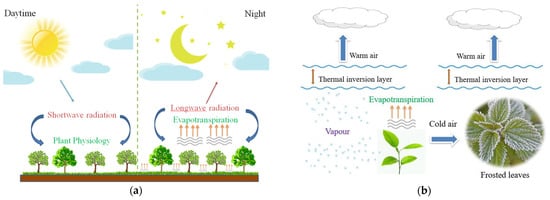Your browser does not fully support modern features. Please upgrade for a smoother experience.
Please note this is an old version of this entry, which may differ significantly from the current revision.
Frost on plant surfaces, refers to a natural phenomenon in which the water vapor close to the plant canopy is cooled to the frost point by the effect of radiant cooling from ground and solidifies into white crystals on plant surfaces.
- plant surfaces
- frost damage
- crystals
1. Principle of Frost Formation on Plant Surfaces
Frost on plant surfaces, refers to a natural phenomenon in which the water vapor close to the plant canopy is cooled to the frost point by the effect of radiant cooling from ground and solidifies into white crystals on plant surfaces. The process of frost formation is dynamic and changes with various environmental factors [27,28,29,30,31,32,33]. Especially between late autumn and early spring, frost will appear if the temperature drops below 0 °C due to radiation cooling when the night sky is cloudless and has calm winds. At the same time, the surface temperature of a plant body below 0 °C and the water between each cell in the plant body is frozen into tiny ice crystals. These ice crystals need to condensate the water of cells inside the plant, and ice crystals gradually grow. The water inside the cells permeates outwards and solidifies the plant’s protoplast colloid material due to how ice crystals interact, eventually causing crops to wither and die due to cell dehydration within a few hours [34].
The radiative cooling process between soil, plants, and the atmosphere reveals the main mechanism of frost formation. As shown in Figure 1, photosynthesis and evapotranspiration at the canopy between plants and the atmosphere are strong during the day under short-wave radiation, while long-wave radiation at night causes the temperature near the ground to drop significantly; the temperature below the canopy will be about 3 °C lower than the temperature above the canopy, which is called“temperature inversion”[35]. Due to the low temperature near the ground, the supersaturated water vapor in the air will condense into white frost crystals on some objects with poor heat transfer performance on the ground [30]. Specifically, frost will be delayed or even not occur if there are clouds in the sky at night, as they will weaken a large part of the long-wave radiation emitted from the soil and vegetation near the ground. Besides, wind speed has an effect on frost development. As air slowly passes over a cold surface when there is a breeze, the water vapor moves around and facilitates the formation of frost. However, when the wind speed is high, the contact time of the cold surface is too short due to the fast air movement. The upper and lower air easily mixes, and is not conducive to temperature reduction, thus hindering the formation of frost. Generally speaking, frost does not form easily when the wind speed reaches level three or above [7]. Therefore, frost generally forms on a clear, breezy, or windless night in the cold season.

Figure 1. Schematic diagram of plant surface frosting under natural radiation conditions: (a) natural radiation frost formation conditions; (b) principle frost formation on plant surface.
The formation of frost is not only related to the aforementioned weather conditions but is also related to the properties of ground objects. Since frost is generally formed on the surface of a cold object, this indicates that the surface temperature of the object is related to the amount of frost created. In addition, due to the intensity of radiation caused by the temperature drop, the rate of frosting will be affected, and the more intense the radiation energy loss, the faster the surface temperature will decrease.
This entry is adapted from the peer-reviewed paper 10.3390/agriculture11111142
This entry is offline, you can click here to edit this entry!
